Romanian writer Anca made you this list of the very best Romanian food. Forty-seven ideas on what to eat in Romania, something to suit everyone.
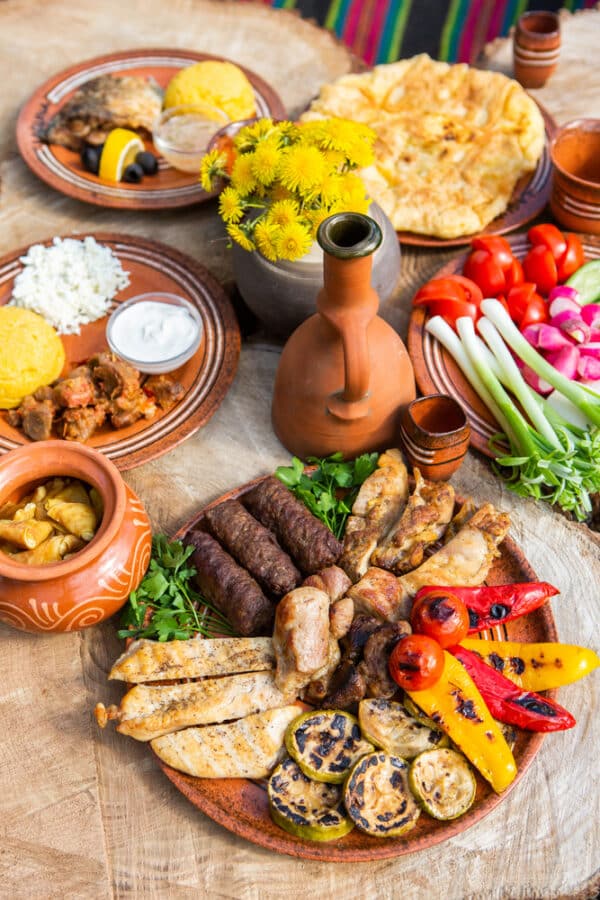
Few tourists make it across the Romanian border and leave without a few extra pounds. Thanks to the fact that the quality of Romanian food is nothing short of exceptional.
Either through ingredient combinations specific to Balkan food or the influence of food typical from nearby Balkan neighbors,
Romanian cuisine is varied, filling, and incredibly savory.
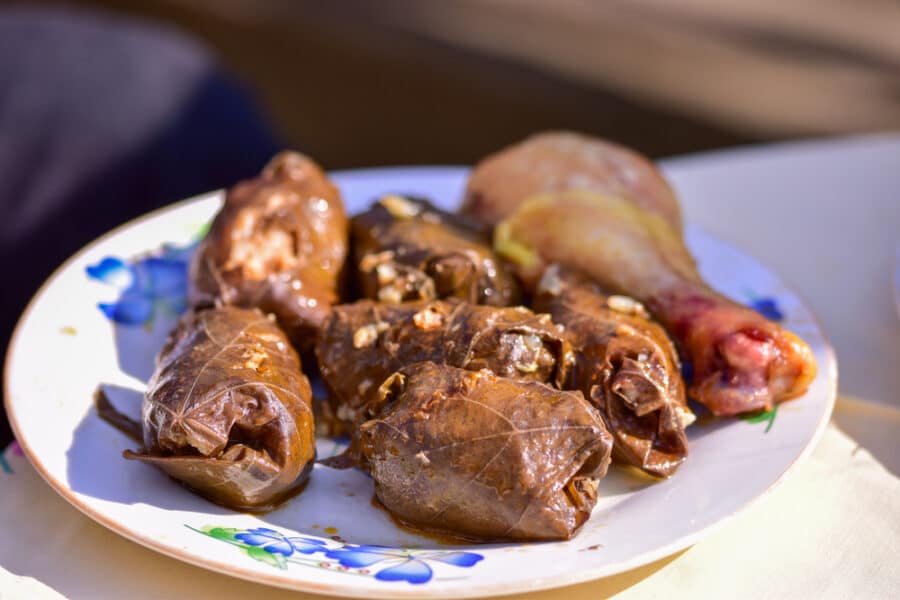
Some will say that while visiting Romania, whether in Transylvania or lesser-known parts of the country, you will feast your eyes on some fantastic natural beauties and ancient architecture.
In reality, you will also literally feast on authentic Romanian food, so make sure to pack some loose pants and make time to enjoy these popular dishes.
So now, you might wonder, “What is traditional Romanian food?” or “What to eat in Romania.”
Therefore, to ensure you are not wasting any opportunities in a restaurant, this Romanian food blog post contains the best traditional dishes and drinks you can’t miss while visiting Romania.
Romanian Appetizers
1. Zacusca – Eggplant And Red Pepper Preserve
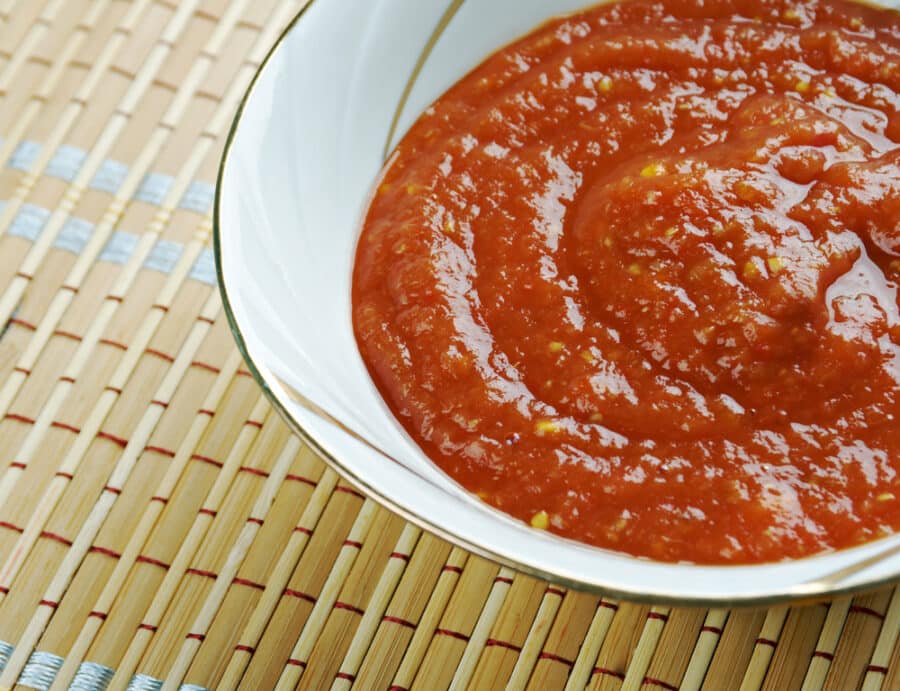
A vegetable paste is made in autumn from the harvested vegetables and served on bread throughout the rest of the year. Baked eggplants, peppers, tomatoes, onions, and mushrooms go into it. However, various Romanian recipes for this dish can be found for this appetizer. Get a recipe here!
2. Salată De Vinete Romaneasca – Eggplant Salad
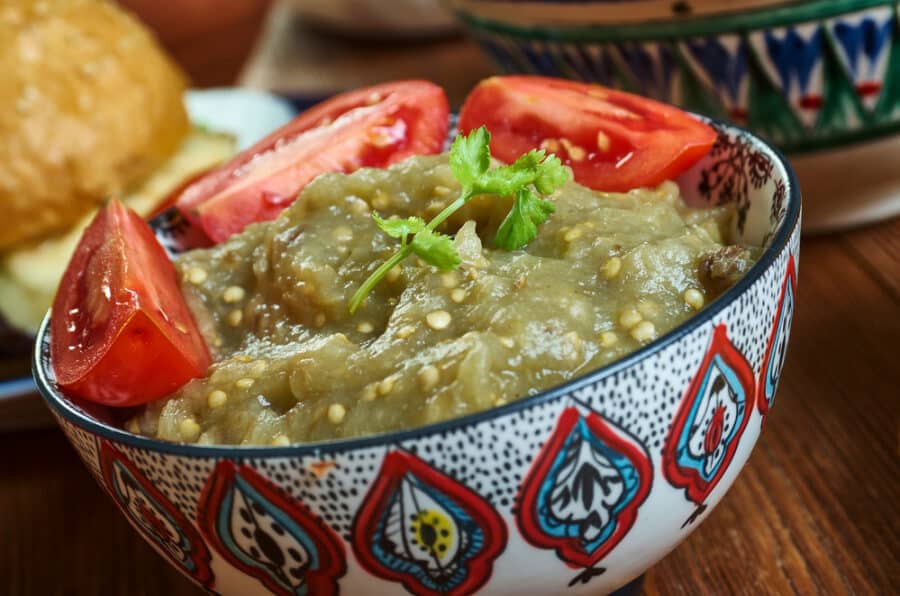
Baked eggplants are chopped minutely and mixed with either chopped onions or mayonnaise. Some Romanian restaurants may throw in some branza de burduf (salty cheese) and tomatoes to complete the platter. As far as easy Romanian recipes go, things don’t really get much easier than this one! It is served on bread.
3. Ouă Umplute – Deviled Eggs

This Romanian dish is an appetizer you will find mainly in the homes of Romanians around every major holiday. To make this traditional Romanian Christmas food, hard-boiled eggs are cut in half, after which the boiled yolk is mixed with liver pate, turned into a paste, then used to fill the egg white.
4. Salata de Boeuf – Romanian Beef Salad
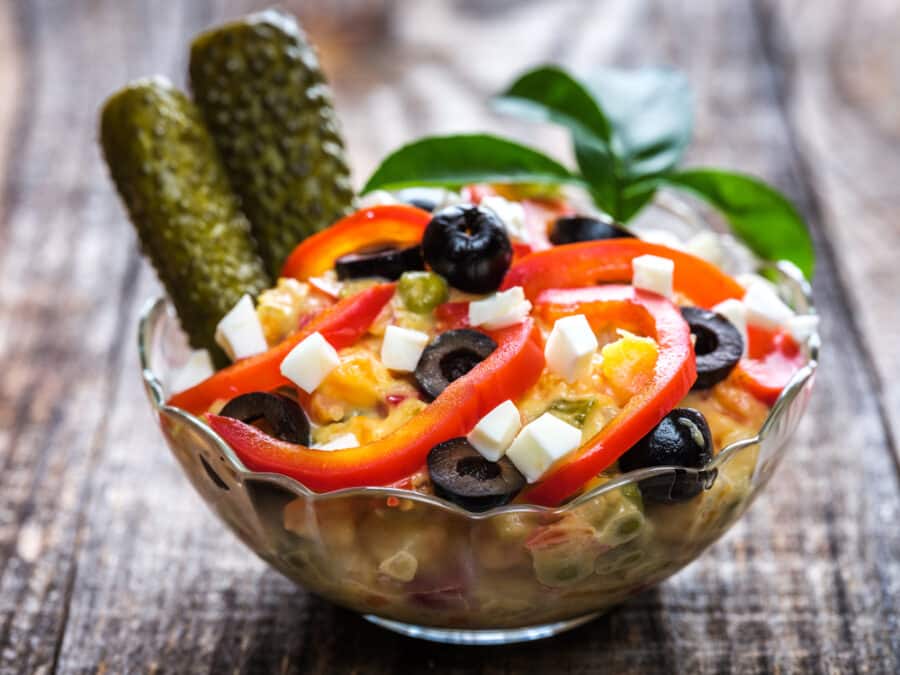
Usually, a French dish known as boeuf salad is served around every major holiday, in restaurants, but mainly in people’s homes. It is made of boiled chicken or beef, potatoes, carrots, parsnip, and pickled cucumbers mixed with mayonnaise, mustard, and some lemon juice.
5. Platou Cu Mezeluri – Cold Cuts Platter
In Romanian, a cold cuts platter is often referred to as “platou cu mezeluri.” Here, “platou” means “platter” and “mezeluri” refers to cold cuts or deli meats.
This platter usually consists of a variety of sliced meats, sausages, and sometimes cheeses, served as appetizers or snacks.
Popular favorites are pastrami, salami, muscle, sausages, and other delicacies that will go on this platter.
It will be paired with salty cheese (telemea), chopped onions, mustard, and bread. A very rural spread, cold-cut platters are some of the best Romanian snacks you’ll find!
6. Salată De Icre – Roe Salad

You will mainly find this very popular Romanian food in fish restaurants in cities or in their more authentic counterparts situated by the sea or in the Delta, cherhana (a place where you eat what has been caught by the fishermen).
This salad is prepared with the freshest roe, oil, and a pinch of salt. The one I ate in Bucharest was topped with chopped red onion – delicious!
7. Slaninuta Afumata cu Boia – Smoked Bacon
A staple in Romanian gastronomy, Slaninuta Afumata cu Boia is smoked bacon, often seasoned with a generous dusting of sweet paprika (boia).
The process of smoking the bacon imparts a deep, woodsy flavor. At the same time, the paprika adds a touch of sweet and smoky spice, making it a savory treat enjoyed in thin slices or incorporated into a myriad of Romanian dishes to enhance its flavor with its rich, smoky notes.
Romanian Soups
8. Ciorbe
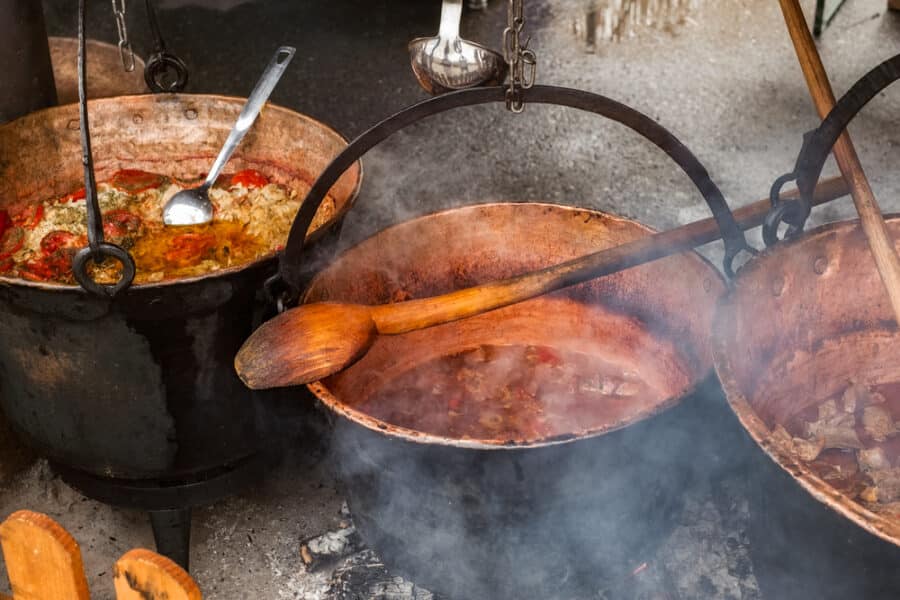
This is a sour soup, and you will find it EVERYWHERE. It is totally typical Romanian food.
You will discover that Romanians are more likely to choose these over sweet soups any day. These Romanian traditional food soups are made with meat and vegetables.
As Romanian food tradition dictates, it is always served with bread, sour cream, and hot peppers.
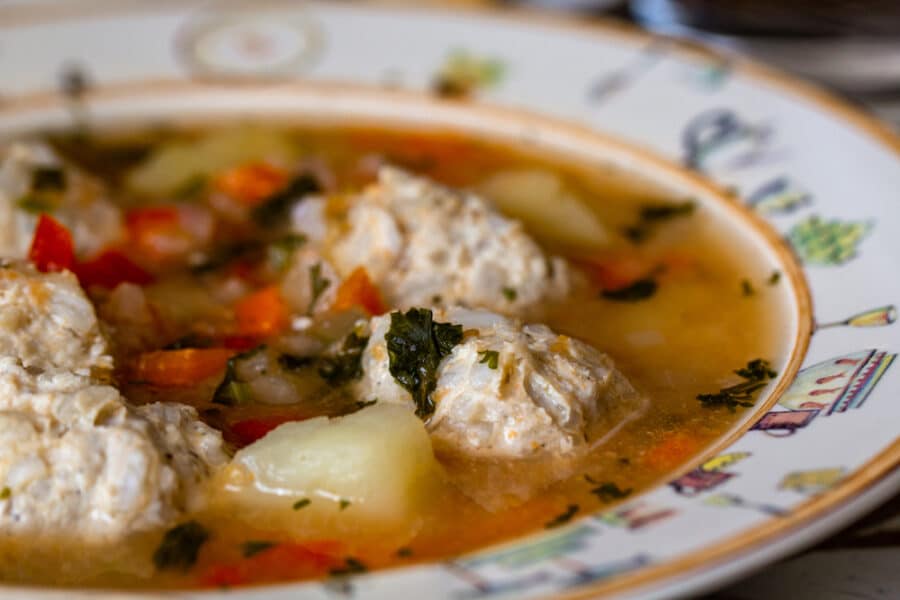
You can have tripe ciorba, chicken or beef ciorba, beans, and vegetable ciorba. There are many variations of this traditional Romanian food. On menus, you find them under ciorbă de burtă, ciorba radauteana, ciorba de fasole, ciorba de pui a la grec.
9. Ciorba Radauteana – Radauti Soup
Originating from the northern part of Romania, Ciorba Radauteana is a cherished soup that merges the comfort of classic chicken soup with the unique tanginess typical of Romanian ciorbas (sour soups).
The soup consists of chicken, vegetables, and, traditionally, a souring agent like lemon juice or borș (fermented wheat bran).
Often enriched with cream and garlic sauce, Ciorba Radauteana carries a soothing yet vivacious flavor profile, providing a warm and revitalizing dining experience.
10. Ciorba de Burta – Beef Tripe Soup
Ciorbă de Burtă is a quintessential Romanian dish revered for its rich flavor and comforting, hearty nature.
This traditional tripe soup combines finely prepared beef tripe, garlic, and sour cream, often seasoned with vinegar or lemon juice, to introduce a zesty freshness that counterbalances the robust, meaty undertones.
Topped with hot pepper and served with a side dish of ardei iute (hot pepper), it’s known not just for its intriguingly complex flavor palette but also for its rumored restorative properties, often hailed as a remedy after a night of indulgence.
Note: in case you were wondering what tripe is, is the stomach of a cow – well, the lining of the tummy. This part of an animal is tough and requires long cooking times, which is why soups taste so good.
11. Tochitura Moldoveneasca – Moldovan Stew
Tochitura Moldoveneasca, hailing from the Moldova region, is a hearty stew, typically prepared with several types of meat, such as pork, sausages, and sometimes even liver, all simmered to perfection in a rich, savory tomato juice.
Accompanied by mamaliga (polenta) and often crowned with a fried egg, Tochitura is a fulfilling, soul-warming dish that permeates Romanian tables with its robust and deeply savory aroma.
Brands We Use And Trust
Romanian Main Dishes
12. Sarmale – Sour Cabbage Rolls
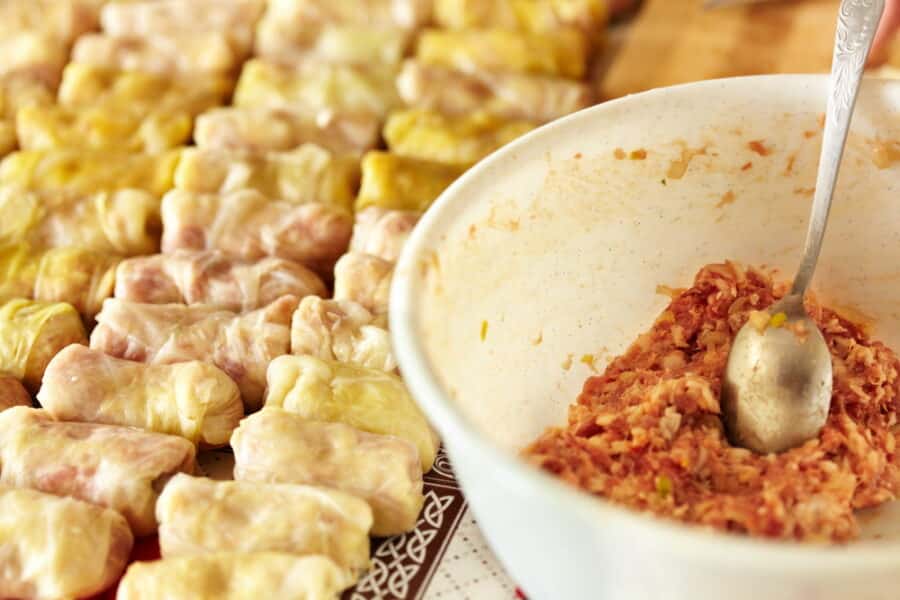
Of all traditional Romanian foods to try, these cabbage rolls are THE most Romanian dish of all Romanian dishes.
Romanian sarmale could be considered the Romanian national food dish; that’s how common and popular this is. This dish consists of minced meat, rice, and onions rolled in sour cabbage leaves or sometimes vine leaves and cooked slowly for hours.
One of the best Romanian foods to try is served with soft polenta and sour cream.
13. Mici – Skinless Sausages
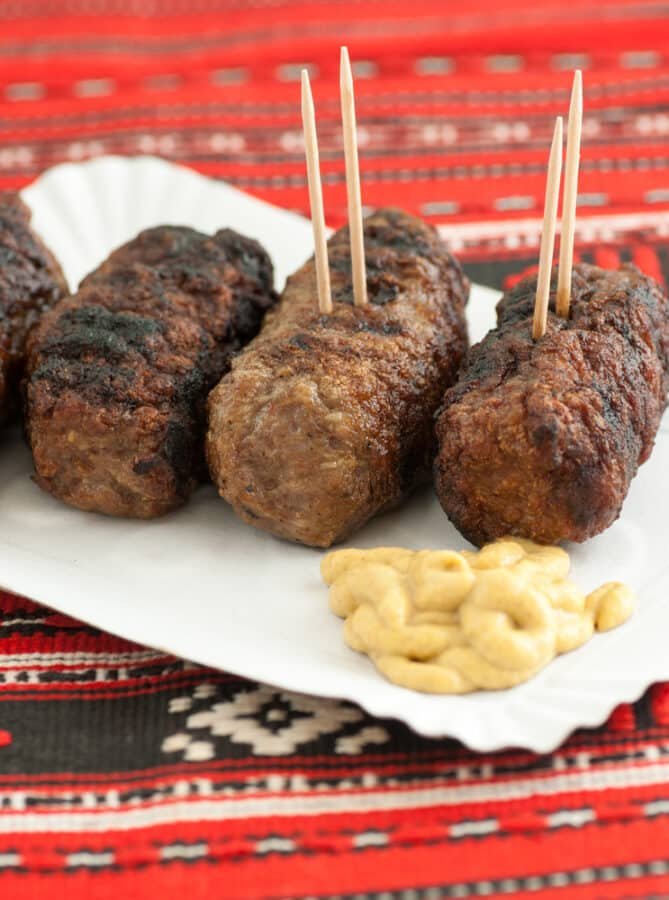
Well-seasoned red meat, minced and grilled to perfection. Legend has it that this Romanian food was invented in a Bucharest train station restaurant when one of the clients asked for sausages, but the owner was out of the casing and only served the grilled filling.
People usually eat them with french fries, a salad, pickles, or bread and mustard—one of those genuinely delicious Romanian meat dishes.
Meat lovers will undoubtedly want to try this; it’s one of the most popular foods in Romania.
14. Tochitura – Romanian Pork Stew

It is a traditional Romanian dish made of pork (often various cuts, including the liver), which is fried and then simmered in a tomato sauce. It is usually seasoned with garlic, bay leaves, and other spices.
Tochitura is commonly served with polenta (“mămăligă”) and a side of cheese and sometimes topped with a fried egg. It’s a hearty dish and is especially popular in the region of Moldova in Romania.
15. Fasole Cu Ciolan – Beans With Smoked Ham Hock

This is a bean stew with pork and ham. A classic Romanian food dish, it pairs excellently with pickles and polenta. Some versions of it may come with sausages.
The dish consists of white beans that are cooked until tender, often in a flavorful broth with tomatoes, onions, and various spices.
The smoked pork hock (ciolan afumat) adds a rich, smoky flavor to the beans. Once the dish is cooked, the meat from the pork hock becomes tender and is usually mixed in with the beans. I
This hearty dish is especially popular during colder months.
16. Mamaliga Cu Branza Si Smantana – Polenta With Cheese & Sour Cream
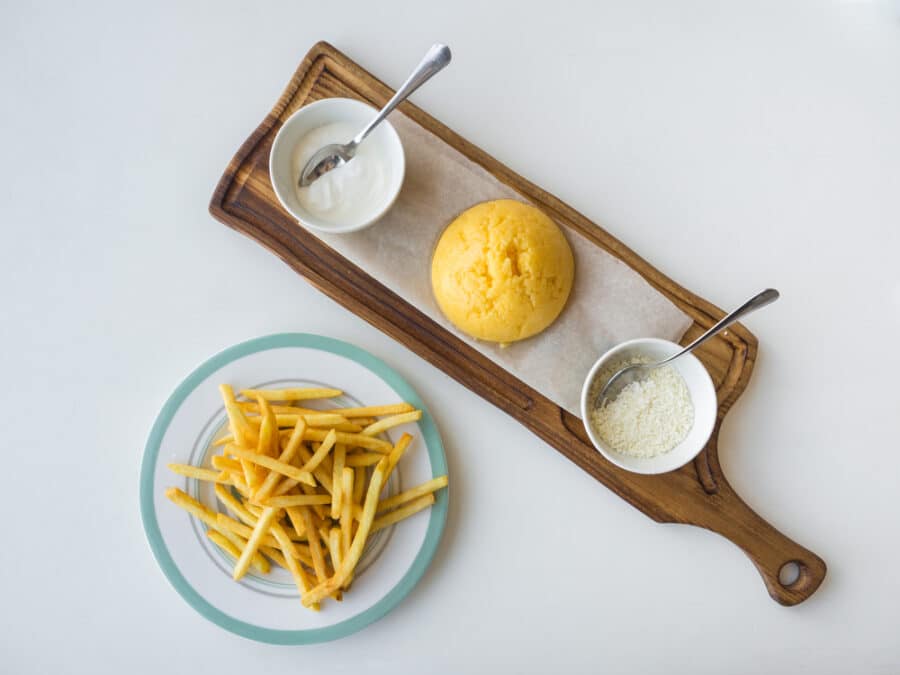
Some people have this traditional Romanian cuisine for an appetizer, while others claim to get full on this dish alone. It is soft polenta served with cottage cheese and sour cream. The dish is straightforward and very delicious, and you will find it in many restaurants throughout the country.
- “Mămăligă” is the Romanian word for polenta, which is a dish made from boiled cornmeal
- “Brânză” means cheese, often referring to a type of Romanian feta cheese or other local cheeses
- “Smântână” is sour cream
17. Drob De Miel – Lamb Liver Meatloaf
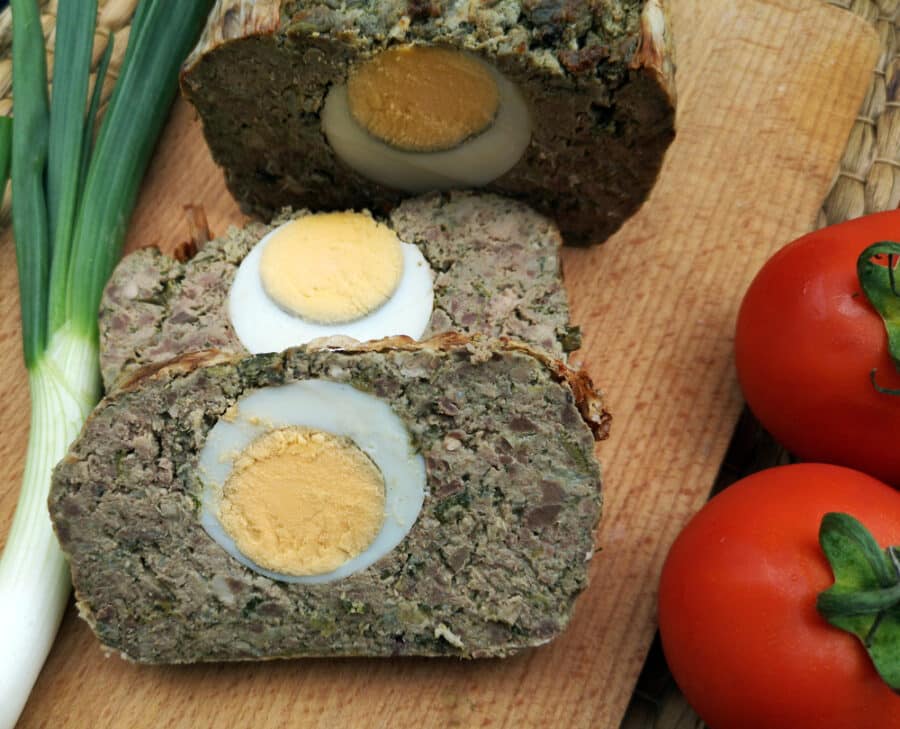
If you visit Romania around Easter, you will see drob in restaurants and at festive meals. It’s one of the classic Romanian meals for celebrations and other festivities. It is something like a meatloaf with hard-boiled eggs inside.
The ingredients for the loaf are cooked minced lamb organs, green onions, eggs, herbs, and milk-soaked bread. Some people replace lamb meat with chicken or turkey.
18. Chiftele – Romanian Meatballs
Hmmmm meatballs. My boys loved these on our travels. They can be made from meat, preferably pork, or the lighter version with chicken or turkey. Some restaurants like to spruce up the recipe and cover them in sesame.
Unlike some other cultures’ meatballs that might be cooked in a sauce, “chiftele” are usually made from minced meat, breadcrumbs, garlic, onions, and various spices. They are shaped into small patties or balls and then deep-fried until golden and crispy.
They can be served as a main dish with side dishes or used as an appetizer. Some variations might include vegetables or rice in the mix.
19. Pomana Porcului
One of the classic Romanian dishes’ names means “honoring the pig,” and it is served after the animal has been sacrificed for Christmas dinner.
This tradition involves preparing and consuming various dishes made from freshly slaughtered pig. The event not only honors the pig but also provides an opportunity for families and neighbors to come together, share food, and celebrate.
In the context of food, if you mention “Pomana Porcului,” you’re referring to the array of dishes made from the pig during this feast, which can include sausages, “sarmale” (cabbage rolls), “tochitura” (pork stew), and many other pork-based dishes.
This pork dish is stewed with delicious tomato sauce, garlic, and herbs. Then, it is served with soft polenta. But you do not have to travel to Romania around Christmas to have it, as it is a regular on the menus of many places to eat in Romania.
20. Tocana – Romanian Stew
This is the name of any meat or vegetable stew. Romanians can be very creative in their combinations, and traditional Romanian food recipes are as varied as the cooks themselves, so you wait and see what you find on the menu.
This would be a great choice if you want to try some down-to-earth Romanian cultural food.
21. Iahnie – Bean Stew
The most common version, “Iahnie de fasole,” is made from white beans cooked with tomatoes, onions, garlic, and various spices.
The stew is hearty and flavorful, often enriched with smoky flavors of meat, like smoked sausage or smoked ham hock, is added. It’s a traditional dish enjoyed across Romania and is especially popular during colder months.
It’s often served alongside pickles and with bread or polenta (“mămăligă”).
22. Ciulama De Pui – Chicken Ragout
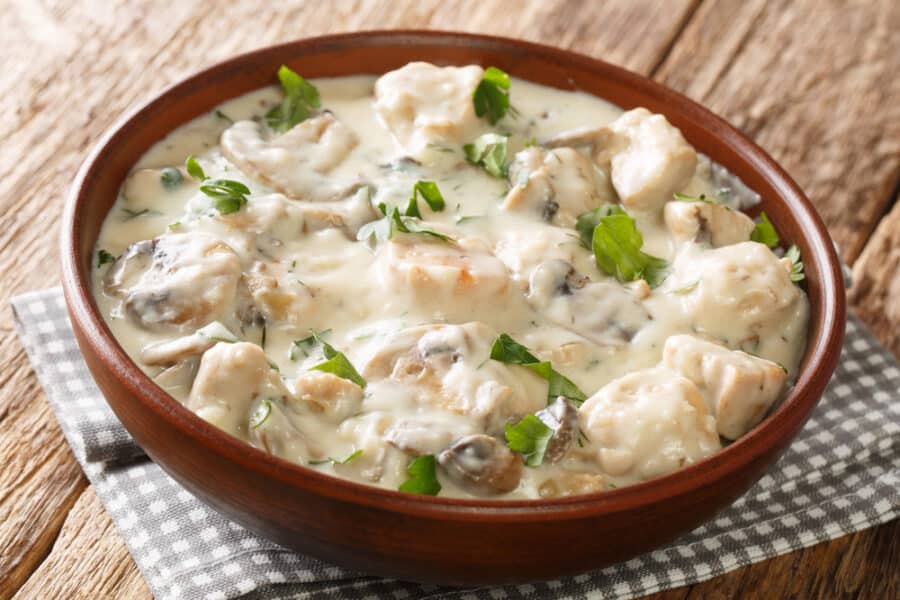
This is chicken and mushrooms, served with a salty white sauce. There is also the version of chicken and mushrooms served in sour cream.
In this dish, chicken pieces are simmered in a roux-based sauce that often includes ingredients like butter, flour, and sour cream or yogurt, resulting in a rich, creamy consistency.
Both of them are delicious. Vegetarians can opt for simple mushroom ciulama, as the sauce is made with corn flour, salt, and vegetable oil.
- “Ciulama” refers to a creamy stew
- “Pui” means chicken.
23. Ardei Umpluti – Stuffed Peppers

The peppers, usually bell peppers, are filled with a mixture of minced meat (commonly a combination of pork and beef), rice, onions, and various seasonings (much the same as the sour cabbage rolls).
After being stuffed, the peppers are placed in a pot and covered with a tomato sauce or broth, then simmered until the peppers are tender and the filling is cooked through.
It’s a flavorful dish that’s enjoyed in many cultures with various adaptations, but in the Romanian context, “ardei umpluți” often comes with a side of sour cream and is sometimes accompanied by bread or polenta.
24. Plachie – Fish Stew
In this dish, fish (commonly carp, but other types can be used) is layered with slices of onion, bell peppers, and tomatoes and then seasoned with salt, pepper, and sometimes paprika or other spices.
It’s then simmered, often with a bit of oil or tomato sauce, until the fish is tender and the flavors meld together.
The dish is aromatic and flavorful, and it’s usually served with polenta (“mămăligă”) on the side, which complements the rich flavors of the stew. Definitely one of the healthiest Romanian food ideas we’ve listed.
25. Fried Fish – Pește Prăjit
Traditional Romanian cuisine goes way beyond meats and stews. Romanians like to dunk all sorts of fish in a combination of beaten eggs and cornflour, fry them, then serve them with polenta and garlic sauce.
And you will love to eat fish like this as well.
- “Pește” means “fish” and
- “Prăjit” means “fried”
Romanian Desserts
26. Papanasi – Romanian Doughnuts

If you’re wondering what they eat in Romania after dinner or the main course, this is it. You will totally fall in love with this Romanian dessert. It’s cottage cheese, sweetened and combined with semolina. The mixture is given the shape of a doughnut, passed through bread crumbs, and fried.
You usually get two papanasi in one serving. The doughnuts are covered with a dollop of sour cream and jam and topped with a small ball made of the same ingredients. Watch out for portion sizes, though. Some restaurants tend to be very generous with theirs.
27. Clatite – Romanian Crepes
This is the equivalent of pancakes but closer to the French crepes. You can have them with sweet cottage cheese, raisins, chocolate, or delicious jams.
If you are lucky enough, you might end up in a traditional restaurant serving salty crepes with meat, cheese, and mushrooms.
28. Strudel cu Dovleac – Traditional Romanian Pumpkin Strudel
Strudel cu Dovleac interweaves the sweetness of pumpkin with the flaky, buttery delight of pastry, resulting in a dessert that is both comforting and luxuriously indulgent. Thin layers of pastry envelop a filling of sweetened pumpkin, often spiced with cinnamon and accented with raisins or nuts. Baked to a golden perfection, this Romanian pumpkin strudel becomes a symphony of crisp, sweet, and spiced notes, enjoyed both as a casual treat and a festive dessert.
29. Mucenici – Sweet Dough Rolls
Mucenici, celebrated principally on the 9th of March, carries a deep cultural and religious significance in Romania, symbolizing the 40 martyrs of Sebaste.
These sweet dough rolls, typically shaped like an eight or fashioned into a small wreath, are either boiled and sprinkled with honey and chopped nuts or baked and brushed with honey syrup, depending on the region.
Mucenici is not merely a dessert but a confection that binds culinary pleasure with tradition and spirituality.
30. Cozonac – Romanian Sweet Bread

This is the biggest challenge in Romanian cuisine. Think of this hearty yet sweet Romanian food as a loaf of sweet, well-kneaded dough wrapped around cocoa and minced nuts, Turkish delight, and raisins.
Kneading this dough is very demanding, and it takes a long while to get it done. However, the results are incredible, and Romanians cannot imagine Christmas or Easter without it. It is a staple dessert to enjoy after a Romanian Christmas dinner.
You will probably have it if you travel around the holidays and stay at a hotel that offers dinner with traditional Romanian desserts. Or you can pick it up from stores or fairs.
31. Pasca – Romanian Easter Cheesecake
This is the Romanian version of the cheesecake. But unlike the cheesecake that can be served anytime, Pasca is only served at Easter.
Pască is made from a sweet bread dough that is shaped into a round form, often with raised edges. Inside this dough, a filling made of sweet cheese (similar to cottage cheese or ricotta), sugar, eggs, and sometimes raisins or zest is added. The cheese mixture is akin to a cheesecake filling, making the dessert a combination of sweet bread and cheesecake.
The top of the pască can be decorated with a cross or other patterns made from the same dough, symbolizing its religious significance. It’s a staple in Romanian households during the Easter celebrations and complements the other festive foods.
- “Pască” derives from “Pascha,” which refers to Easter in many Eastern Orthodox traditions
32. Poale-N Brau – Romanian Sweet Cheese-Filled Pastry
Poale-n brâu is a traditional Romanian pastry, especially popular in the northern regions of the country.
The dough for “poale-n brâu” is typically leavened, and the filling is made from sweet cheese (often similar to cottage cheese) combined with sugar and sometimes raisins or zest.
Once filled, the dough is folded over to form a half-circle or other shapes and then baked until golden.
The resulting pastry is soft, slightly sweet, and creamy from the cheese filling. It’s often enjoyed during special occasions, holidays, or family gatherings.
- The name “poale-n brâu” literally translates to “skirt in the belt,” which is believed to describe the shape of the pastry, reminiscent of a folded skirt
33. Cornulete – Romanian Jam Or Nut-Filled Pastries
The dough for cornulețe is often rich, made with butter and sometimes even cream or sour cream.
This makes them tender and flaky, similar in texture to shortcrust pastries. They are typically filled with various fillings like jam (especially plum or apricot), ground walnuts mixed with sugar, or Turkish delight.
After being shaped and filled, they are baked until lightly golden and then often dusted with powdered sugar. The combination of the flaky pastry with the sweet fillings makes them a favorite treat for many Romanians.
- “Cornulețe” literally translates to “little horns,” which alludes to their typical crescent or horn-like shape
34. Colțunași – Romanian Filled Dumplings
These dumplings are made from a dough usually consisting of flour, eggs, and water. They can be filled with a variety of ingredients.
Common fillings include:
- Sweet versions: filled with fresh fruits (like cherries or plums), jam, or sweetened farmer’s cheese
- Savory versions: filled with potatoes, cheese, mushrooms, or meat
Once filled, the “colțunași” are shaped into half-moons or other shapes, boiled until cooked, and then they can be served as is, fried for added texture, or topped with various sauces or accompaniments.
For instance, sweet “colțunași” might be served with sugar and cinnamon, while savory ones could be accompanied by sour cream or a garlic sauce.
They are somewhat similar to Polish pierogi, Russian pelmeni, or Italian ravioli in concept but with their own distinct Romanian flavors and variations.
35. Profiterol
You will find this in restaurants, so we figured you wanted to know what it is. Not a traditional dessert per se, but a dessert often found in restaurants. It consists of several scoops of ice cream served with small eclairs and chocolate toppings.
36. Plum Dumplings – Găluște Cu Prune
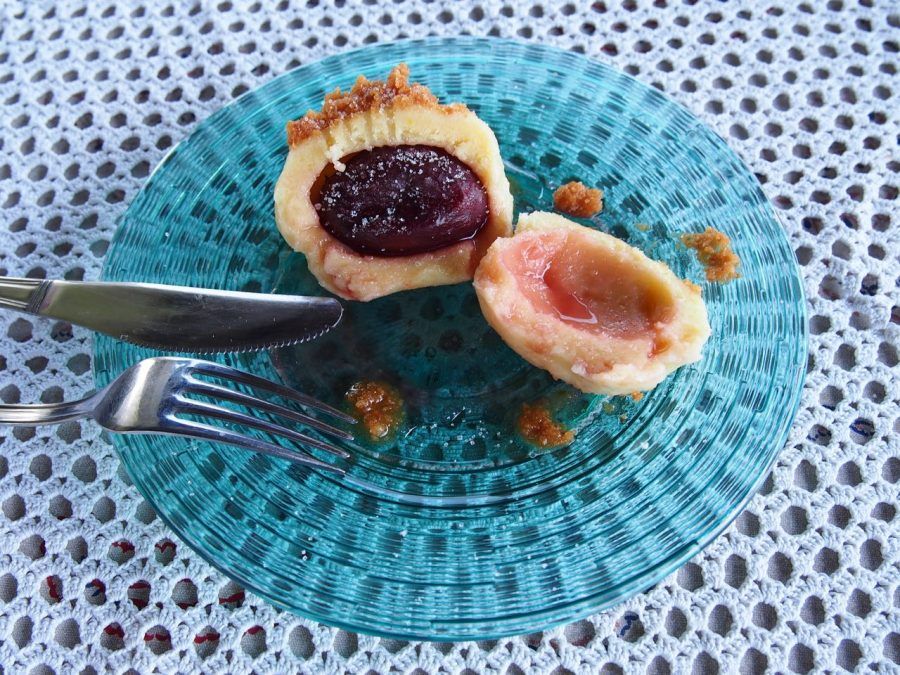
These are dumplings typically made from potato dough that encases whole or halved plums, and after boiling, they are often rolled in breadcrumbs fried with sugar and butter.
They’re a delicious sweet treat, often enjoyed as a dessert or even a main dish in some Romanian households.
- “Găluște” means “dumplings,” and
- “Prune” means “plums”
37. Papanasi – Romanian Donuts
Papanasi, a cherished Romanian dessert, invites indulgence with its sweet, creamy, and slightly tangy flavor profile.
These fried or boiled doughnuts, often made from a mixture of cow’s cheese, flour, and eggs, are typically served adorned with sour cream and a generous dollop of fruity jam or compote.
The play between the sweet, creamy, and slightly savory elements makes Papanasi a delightful conclusion to a Romanian meal, fulfilling the desire for a luxurious and refreshingly light dessert.
38. Gogosi – Doughnuts
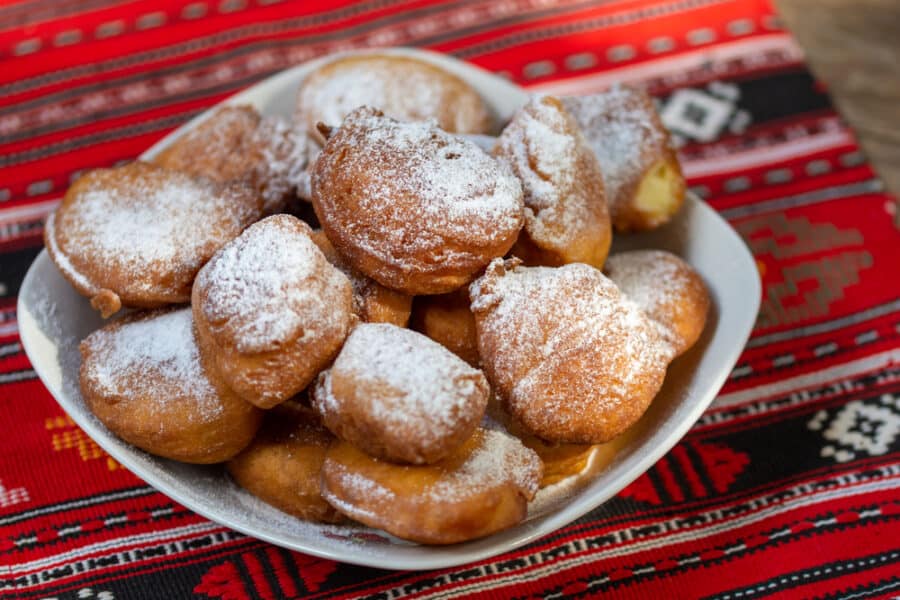
Gogoși are deep-fried dough pastries, usually sweet, and can be filled or unfilled.
The traditional ones are round and fluffy, often dusted with powdered sugar or granulated sugar. Some might have fillings like jam, chocolate, or sweet cheese.
They’re a popular treat in Romania and can be found in bakeries, at fairs, and are often made at home. The concept is similar to doughnuts in many cultures but with regional variations in the recipe and preparation method.
39. Placinta – Romanian Pie
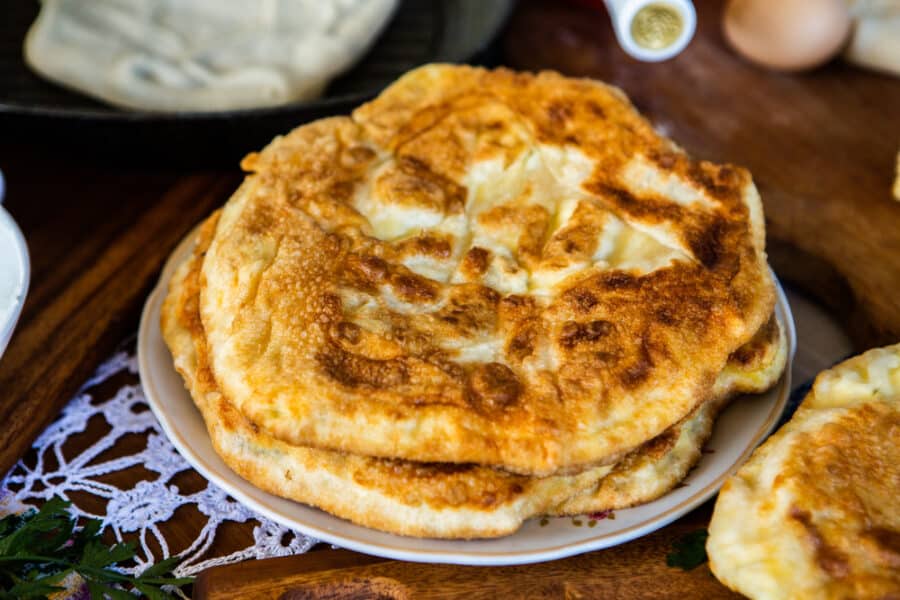
The Romanian version of a pie is different from the American version. It is usually made in a large, square tray, with one dough sheet on the bottom, a filling, and another sheet of dough on top.
“Plăcintă” can be either baked or fried and comes in various sizes and shapes, depending on the region and specific preparation. They can have a variety of fillings, including:
- Sweet versions: filled with apples, sweet cheese, pumpkin, or jams
- Savory versions: filled with potatoes, cheese, cabbage, or meat
The term “plăcintă” is derived from the Latin word “placenta,” which originally referred to a type of cake.
My Favorite Romanian Dishes
40. Placinte – Romanian Pies
Placinte denotes a beloved category of Romanian pies, celebrated for their versatility and ubiquity across various occasions.
With fillings ranging from sweet to savory, including cheese, potatoes, sweetened pumpkin, and apples or cherries, each Placinta offers a unique gustatory experience. Whether enjoyed as a hearty snack, a sweet treat, or a comforting meal, Placinte embodies the heartiness and warmth of Romanian culinary arts.
41. Frigarui – Romanian Kebab
Frigarui, essentially Romanian kebabs, are synonymous with festive outdoor cookouts nationwide. Skewers of marinated meat – often pork, chicken, or beef – are interspersed with vegetables like bell peppers, onions, and tomatoes, then grilled to perfection.
The marinades, often based on garlic, oil, and local herbs, infuse the meat with a tantalizing aroma, making Frigarui a beloved choice for social gatherings and family barbecues.
Move This Adventure To Your Inbox & Get An Instant Freebie

No spam. Unsubscribe at any time.
Romanian Drinks

42. Vin – Wines
You can’t genuinely appreciate Romanian cooking without having a pairing of Romanian wines. They are world-famous, and you will enjoy them. The best thing to do is to follow servers’ recommendations, often suggesting the perfect wine pairings with traditional Romanian dishes.
Some of the most popular types of wine are:
- Grasa
- Tamaiosa
- Feteasca Neagra and
- Busuioaca
Popular brands include Cotnari, Jidvei, Murfatlar, and Beciul Domnesc. As far as expensive and old wines are concerned, it depends on the supplier of each restaurant.
43. Țuică – Romanian Plum Brandy
Romanians will usually test your alcohol resistance when offering tuica.
This spirit can contain 40-55% alcohol by volume and is only made of fermented plums. You will also find the cereal version of tuica under the name of rachiu or the same thing as tuica under that other name.
It’s a clear spirit made primarily from the fermentation and distillation of plums, although other fruits can sometimes be used. Țuică is quite potent, typically containing an alcohol content ranging from 40% to 60% or more.
It’s often homemade in rural areas, with families having their own recipes and distillation methods passed down through generations.
Țuică plays a significant role in Romanian culture and traditions, commonly offered to guests as a gesture of hospitality and consumed at various celebrations and gatherings.
44. Palinca
Pălincă is another traditional Romanian (and also Hungarian) distilled beverage, similar to Țuică but with some distinctions.
While Țuică is predominantly made from plums, Pălincă can be made from a variety of fruits, including plums, apples, pears, cherries, and apricots, among others. The process involves fermenting the fruit and then distilling the resulting mash.
Pălincă is known for its high alcohol content, often exceeding 50%, and its strong, fruity aroma. Like Țuică, Pălincă is deeply rooted in the cultural and social fabric of Romania, often being homemade and enjoyed during celebrations, family gatherings, and as a warm welcome for guests.
45. Visinata – Sour Cherry Liqueur) & Afinata – Sour Cherry Liqueur
Vișinată and Zfinată are traditional Romanian alcoholic beverages made by macerating fruits in sugar and alcohol.
- Vișinată: This is a cherry liqueur made from sour cherries, sugar, and alcohol (usually Țuică or another clear spirit). The cherries and sugar are layered in a jar and left to macerate for a period of time. After the sugar dissolves and the cherries release their juices, alcohol is added. The mixture is then stored and aged for several months before it’s ready to be consumed. The result is a sweet and slightly tart liqueur
- Afinată: This is a blueberry liqueur made in a similar manner to Vișinată, but using blueberries (afine) instead of cherries. The process involves macerating blueberries with sugar, then adding alcohol and allowing the mixture to age.
Both of these liqueurs capture the essence of the fruits they’re made from and are enjoyed either as digestifs or in various cocktails or culinary preparations. They’re also popular homemade beverages in many Romanian households.
Other Romanian Food You Must Try
46. Murați – Pickled Veggies
Pickles are essential to many Romanian food recipes and Romanian cuisine in general. Most Romanians will pickle their own fruit and vegetables and compete with each other in how great the result is.
Literally, any vegetable can be pickled in a combination of salt and water. Cucumbers, green tomatoes, small watermelons, grapes, apples, cauliflower, and carrots are the most popular pickled foods.
47. Mujdei – Romanian Garlic Sauce
This Romanian garlic sauce is fantastic. And we expect you will develop a taste for it by the end of your trip. Or, just like the locals, you can end up ordering food you can eat it with.
It’s a simple yet flavorful sauce primarily made from crushed garlic cloves, water or oil, and salt. Some variations might include vinegar or lemon juice for added tanginess or even a bit of yogurt to mellow out the strong garlic flavor.
Wrap Up On Food In Romania
As you can now see Romanian cuisine is a delightful fusion of flavors inherited from its diverse historical influences – from the Romans to the Ottomans, and from the Greeks to the Hungarians.
If there’s one thing that stands out about this cuisine, it’s the way it reflects the country’s storied past and rich traditions. Take, for example, the beloved “mămăligă,” Romania’s version of polenta.
Originally a peasant dish, mămăligă has risen through the ranks over the centuries, becoming a staple that’s now found on almost every Romanian dinner table. It’s a dish that speaks volumes about the nation’s ability to take the simple and turn it into something universally loved.
So, if you find yourself wandering the streets of Bucharest or exploring the Transylvanian countryside, make sure to dig into the local fare. Romanian cuisine tells a story – of its land, its history, and its people. And trust me, it’s a tale best experienced with a fork in hand.
So, now that you are now well versed on the best food in Romania to eat while you are on vacation.
Don’t forget to bring your stretchy pants so you can try not only the national dish but also get to know Romanian culture through many more dishes!
- What To See When You Visit Romania
- Things To Do In Romania
- Best Time To Visit Romania
- Bucharest Tours
- Bears’ Cave Romania Guide
- Things To Do In Brasov, Transylvania
- Where To Stay In Brasov
- Souvenirs To Bring Home From Romania
- Luxury Hotels In Romania
- Traveling As A Vegan In Romania
- 7 Day Romania Road Trip Itinerary


Absolutely awesome food. Very similar to Hungarian, that said about 1,000,000 live in Transylvania
Veery stupid comment about Hungarians and Transilvania.
Thank you for sharing this valuable and meaningful content with us. It will be very useful for me.
it’s not the cevapi recipe, that recipe is entirely different